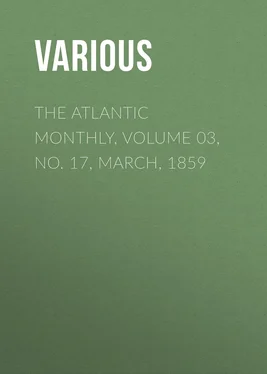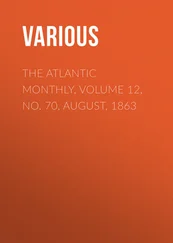Various - The Atlantic Monthly, Volume 03, No. 17, March, 1859
Здесь есть возможность читать онлайн «Various - The Atlantic Monthly, Volume 03, No. 17, March, 1859» — ознакомительный отрывок электронной книги совершенно бесплатно, а после прочтения отрывка купить полную версию. В некоторых случаях можно слушать аудио, скачать через торрент в формате fb2 и присутствует краткое содержание. Жанр: foreign_antique, periodic, foreign_edu, на английском языке. Описание произведения, (предисловие) а так же отзывы посетителей доступны на портале библиотеки ЛибКат.
- Название:The Atlantic Monthly, Volume 03, No. 17, March, 1859
- Автор:
- Жанр:
- Год:неизвестен
- ISBN:нет данных
- Рейтинг книги:5 / 5. Голосов: 1
-
Избранное:Добавить в избранное
- Отзывы:
-
Ваша оценка:
- 100
- 1
- 2
- 3
- 4
- 5
The Atlantic Monthly, Volume 03, No. 17, March, 1859: краткое содержание, описание и аннотация
Предлагаем к чтению аннотацию, описание, краткое содержание или предисловие (зависит от того, что написал сам автор книги «The Atlantic Monthly, Volume 03, No. 17, March, 1859»). Если вы не нашли необходимую информацию о книге — напишите в комментариях, мы постараемся отыскать её.
The Atlantic Monthly, Volume 03, No. 17, March, 1859 — читать онлайн ознакомительный отрывок
Ниже представлен текст книги, разбитый по страницам. Система сохранения места последней прочитанной страницы, позволяет с удобством читать онлайн бесплатно книгу «The Atlantic Monthly, Volume 03, No. 17, March, 1859», без необходимости каждый раз заново искать на чём Вы остановились. Поставьте закладку, и сможете в любой момент перейти на страницу, на которой закончили чтение.
Интервал:
Закладка:
Among the remaining subjects, which we cannot examine particularly, or in their order, are those of the Old Man and Old Woman led by Death, each to the sound of a dulcimer;—the Physician, to whom in mockery Death himself brings a patient;—the Astronomer, to whom the skeleton offers a skull in place of a celestial globe;—the Miser, from whom Death snatches his hoarded gold; and the Merchant, whom the same inexorable hand tears away from his ships and his merchandise;—the storm-tossed ship, with Death snapping the mast;—a Count, dressed in the extreme of courtly splendor, who recognizes Death in the disguise of a peasant who has flung down his flail to seize his lordship's emblazoned shield and dash it to pieces;—a Duchess, whom one skeleton drags rudely from her canopied bed, while another scrapes upon a violin;—a Peddler;—a Ploughman, of whose four-horse team Death is the driver;—Gamblers, Drunkards, and Robbers, all interrupted in their wickedness by Death;—a Wagoner, whose wagon, horse, and load have been tumbled in a ruinous heap by a pair of skeletons;—a Blind Beggar, who stumbles over a stony path after Death, who is his deceitful leader, and who turns back with a look of malicious glee to see his bewilderment and suffering;—and a Court Fool, whom Death, playing on bagpipes, and dancing, approaches, and, plucking him by the garment, wins him, with a coaxing leer, to join his pastime.
A few others claim our more particular attention. Among them is a Knight, armed cap-a-pie, who is run through and through, from back to front, by Death, himself half armed in mockery. There is a concentrated vigor in the thrust of the lance, and a cool venom in the countenance of the assailant, that we may seek in vain in the works of famous battle-painters; and it must always be remembered that Holbein's figure is entirely without those indications of muscular movement by which we express our feelings,—in fact, a mere bare-boned skeleton.
A Bride at her wedding-toilet, whom Holbein has contrived to make almost beautiful, receives a robe from one attendant; another clasps round her neck a collar—of gold and jewels? No,—of bones, and with bony fingers. And the next cut to this shows us the Bridegroom and Bride walking through an apartment hung with arras, while before them dances Death, beating a tabor, like a child beside himself with joy.
One of the finest and most touching conceptions in the whole series represents a dilapidated Cottage,—a mere shanty, so wretched that the love of those who live in it is all their happiness,—nay, all their comfort. The mother is preparing for two little children the simplest and poorest of meals, at a fire made of a few small sticks. She finds consolation in the very pranks that hinder her humble task. Death enters,—there is no door to keep him out,—and, seizing the hand of the younger child, who turns and stretches out the other imploringly to his mother, carries him off, remorseless and exulting, leaving her frantic with grief. We may look with comparative indifference, and sometimes even with sympathy, upon his other feats,—but who is there that does not hate that grinning skeleton?—And yet, perhaps, he exults that he has saved one soul, yet pure, from misery and crime.
For vigor of movement the group of Death and the Soldier is preëminent. The field is covered with the wounded and the slain, in the midst of which the soldier encounters his last enemy. The man is armed in panoply, and wields a huge two-handed sword with a vigor unabated by former struggles. Death has caught a shield from the arm of some previous victim; but his only offensive weapon is a huge thigh-bone, which we plainly see will bear down all before it. In the distance another figure of Death flies madly over the hills, beating a drum which summons other soldiers to the field. It is impossible to convey in words the fierce eagerness of this figure, minute as it is, and composed of a few lines.
The forty-seventh composition is one which has puzzled the critics and antiquaries; but it is not easy to conjecture why. It shows us a wretched Beggar, naked, sick, lame,—utterly destitute, miserable, and forsaken,—suffering at once all the ills that flesh is heir to. He sits huddled together on some straw, near a large building, and lifts his hands and face up piteously to heaven. Death is not there; and the antiquaries ask in wonder, Why is the subject introduced? Why, but to show that to him alone who would gladly welcome Death, Death will not come?
The work ends, as a connected series, with the Last Judgment, where Christ, who conquered Death, appears seated on the bow of promise,—with his feet resting on a celestial sphere, attended by angels, and showing to a throng of those who have risen from the grave the wounds by which he redeemed them from its power.
To this is added an ornamental tail-piece called Death's Arms. It shows a skull in a battered shield, which has for a crest a regal helmet surmounted by an hour-glass and two bony arms grasping a stone. The supporters to the shield are a gentleman and lady richly dressed,—said to represent Holbein and his wife.
It is not known, positively, when Holbein drew these designs upon the blocks (for of course he did not engrave them); and it has even been disputed by one or two eminent antiquarian critics, that he designed them at all. But there does not appear to be a single valid reason for thus diminishing his fame. He probably was engaged on them between 1531, the date of his first return to Bâle, and 1538, when they were published,—the year in which he refused the solicitation of his townsmen to return to the home of his childhood and the bosom of his family.
Holbein continued to live in London until the year 1554, when that city suffered a visitation of the plague, similar to that which was the occasion of the painting of the Great Dance of Death at Bâle. Holbein was struck by the disease; and Death, knowing gratitude as little as remorse, triumphed over him who had blazoned his triumphs. Upon the painter's fame, however, and that of his great work, Death could not lay his hand; but so long as the grim tyrant shall claim his victims, so long will he perpetuate the memory of Hans Holbein.
Though he was a royal favorite, it is not known where he died; and the place where lie the ashes of him who, on a king's word, was greater than seven earls, is equally unknown; there is not a line or a stone to mark it. So soon after his death as in the reign of Charles I., (within one hundred years,) a nobleman—noble by nature as well as by birth—desirous of erecting a monument to him, sought his grave, but in vain, and was compelled to abandon his design. And thus was Holbein driven to live among strangers, to die without a wife to console or children to mourn him, and to lay his bones in a nameless grave in a foreign land.
Such is an imperfect and brief account of the origin, the various forms, and the meaning of the Dance of Death, and of the life and character of him whose genius has caused it to be called by his name. It may smell too much of mortality and antiquity for this fast-living and forward-looking age; for it is not only a monument of the past, but an exponent of its spirit. We can look back at it, through the mellowing mist of centuries, with curiosity not unmixed with admiration; but we should turn with aversion from such a work, coming from the hands of an artist of our own day. We think, and with some reason, that we do not need its teachings; for we are freed from the thraldom that gave edge to its democratic satire; and we have learned to look with greater calmness, if not with higher hope, upon the future, to which the grave is but the ever-open portal. But we may yet profit by a thoughtful consideration of the eternal truths embodied by Holbein in his Dance of Death; and in the story of his life there is a lesson for every man, and every woman too, if they will but find it.
Читать дальшеИнтервал:
Закладка:
Похожие книги на «The Atlantic Monthly, Volume 03, No. 17, March, 1859»
Представляем Вашему вниманию похожие книги на «The Atlantic Monthly, Volume 03, No. 17, March, 1859» списком для выбора. Мы отобрали схожую по названию и смыслу литературу в надежде предоставить читателям больше вариантов отыскать новые, интересные, ещё непрочитанные произведения.
Обсуждение, отзывы о книге «The Atlantic Monthly, Volume 03, No. 17, March, 1859» и просто собственные мнения читателей. Оставьте ваши комментарии, напишите, что Вы думаете о произведении, его смысле или главных героях. Укажите что конкретно понравилось, а что нет, и почему Вы так считаете.












